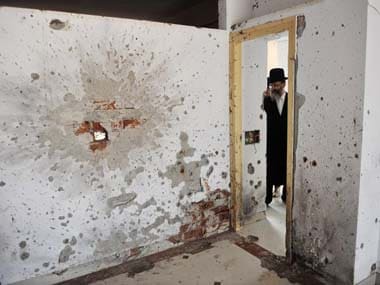On the 10th anniversary of the 26/11 Mumbai terror attacks, the first phase of a memorial dedicated to the victims of the attack will be inaugurated on Monday at the Nariman Light House in south Mumbai’s Colaba area. The Nariman House, also known as Chabad house, has been converted into a ’living memorial’ dedicated to those killed in the carnage. The building itself was renamed as Nariman Light House on Sunday , signifying a new chapter of peace and a beacon of light. The Nariman House, which houses an outreach centre of the Jewish Chabad movement, was one of the theatres of terror on 26 November, 2008, its siege ending with NSG commandos storming the building and gunning down two terrorists who had taken its residents hostage. The first phase of the memorial will comprise a plaque on the roof of the building inscribed with the names of those who died in the 26/11 attack, Rabbi Israel Kozlovsky said on Sunday. [caption id=“attachment_1682935” align=“alignleft” width=“380”]  In this photo taken on November 26, 2009, Rabbi Nachman Holtzberg, father of slain Rabbi Gavriel Holtzberg, visits Nariman House in Mumbai. AP[/caption] The memorial is not only for the ones killed in the building but for all the victims of the attacks. “This is the only place which is dedicated to the victims of the 26/11 attack. The Taj (hotel) has one and the Oberoi (hotel) has a plaque, but those are only for the people killed at those places,” the Rabbi said. “As we know, it was not six different attacks. It was one attack at six different places. We felt that we needed to make a place which will commemorate all those killed,” he added. The plaque would have water constantly streaming from a fountain, signifying the flow of life, and would be surrounded by plants, Kozlovsky said. Six planks with the paintings of the six places targeted that day — the Taj and Oberoi hotels, the Leopold Cafe, the Kuber boat, the Cama Hospital and the Nariman House — would be another feature of the memorial, he added. “The Nariman House will be called the Nariman Light House from Sunday and will serve as a beacon of light. It will be symbolic of the fact that there is light at the end of every tunnel. It is only through positivity that the message of peace can be spread across all humanity,” Kozlovsky said. The second phase of the memorial, expected to be completed in a year, would be located on the fourth and fifth floors of the building and would be themed “from darkness to light”, Kozlovsky said. It would tell the world that the only way to lead life was to abide by the virtues of humanity, spread positivity and become a harbinger of hope, the Rabbi added. The fifth floor is where Rabbi Gavriel Holtzberg and his pregnant wife Rivka lived with their son Moshe. In the attack, while Moshe was saved by his Indian nanny Sandra Samuel while Rabbi Gavriel and Rivka were killed in the attack. “The fifth floor would show the Jewish way of life,” Kozlovsky told The Deccan Herald. When a person reaches the fourth floor, he/she will be able to see the fractured door and the bullet-ridden hall. “Here, there will be an audio-video display of the events of 26/11 and a room on global terrorism,” he said. What happened on 29 November 2008 On the evening of 26 November, 2008, two terrorists — Babar Imran and Nasir — had raided the Jewish centre at the Nariman House and killed four of its residents. One among the eight synagogues in Mumbai, the couple ran a cultural and outreach centre for the Chabad-Lubavitch movement in the five-storey landmark building in south Mumbai’s Colaba area. In the firefight with the National Security Guard (NSG) commandos that lasted two days, the two terrorists were killed. Commando Gajendra Singh Bisht was also killed during the operation. Days after the attack reports emerged indicating that the Chabad house was a prime target of the 26/11 attacks. The two terrorists – Nasir and Imran – had been fed clear instructions to execute the Chabad House siege to perfection. When asked during interrogation why the Nariman House was specifically targetted, Mohammed Ajmal Kasab, the face of the Mumbai terror attacks, reportedly told the police they wanted to sent a message to Jews across the world by attacking the ultra orthodox synagogue, reported DNA. On 26 November, 2008 Islamist militants from Pakistan unleashed a wave of violence across Mumbai that lasted three days, that left 166 people dead and hundreds more injured. They struck several targets in a series of coordinated attacks, including luxury hotels, the city’s main railway station, a restaurant popular with tourists and a Jewish centre. The ten attackers — who were armed with AK-47 assault rifles and hand grenades — belonged to Pakistan-based militant group Lashkar-e-Taiba (LeT).
The Nariman House, which houses an outreach centre of the Jewish Chabad movement, was one of the theatres of terror on 26 November, 2008, its siege ending with NSG commandos storming the building and gunning down two terrorists who had taken its residents hostage.
Advertisement
End of Article


)

)
)
)
)
)
)
)
)



